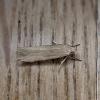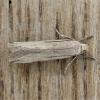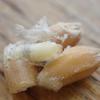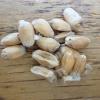35.034 Sitotroga cerealella (Olivier, 1789)
Status and Distribution
Predominantly an adventive species introduced with various stored grain products. It has been attracted to light in the wild on at least three occasions, in Dorset, Essex and Hampshire. Indoor records of the moth and larva have been reported from widely scattered localities in England and Scotland, often at ports. Not recorded from Wales, Ireland, Northern Ireland, Isle of Man or the Channel Islands.

Provisional map
Foodplant and Larval Feeding Signs
Triticum sp. (wheat), Hordeum sp. (barley) and Secale sp. (rye). Additionally indoors, the larva has been found on oats, maize, rice, sorghum, buckwheat and bamboo. It has also been found on dried flowers (presumably the seeds) in a garden centre and in Museums on corn dollies and old stooks of wheat.
There are few external signs of feeding although if an infestation occurs, the small holes in the seeds and dusty frass associated with the feeding can become obvious.
Habitat
In arable areas where its foodplants are cultivated and indoors in grain stores, warehouses etc where suitable stored food exists. The moth is on the extreme northern edge of its natural range in the British Isles.
Finding the Moth
Larva and Adult: infestations are usually only found when the flying adults are observed and this species can cause serious damage to stored products. The adults rest in crevices and cracks in the walls of storage areas. Will occasionally come to light outside.
Similar Species
Could be mistaken for a Metzneria sp. but the pecten (projecting hair scales) on the antennal scape (basal segment) will exclude that genus.
In the wild has been attracted to light in July and August. Elsewhere potentially continuously brooded in heated warehouses and grain stores.





_0.jpg)

